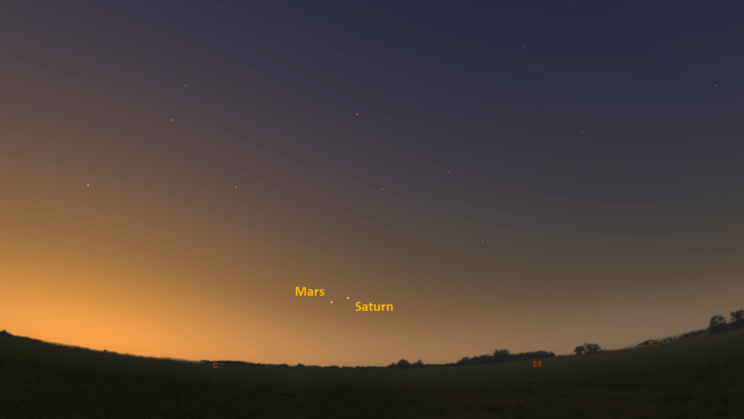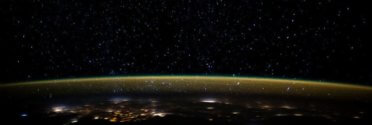This is the Saint Louis Science Center’s NIGHT SKY UPDATE for the week of Saturday, April 27, 2024.
Information updated weekly or as needed.
Times given as local St. Louis time this week will be in Central Daylight Time (CDT). For definitions of terminology used in the night sky update, click the highlighted text. If relying on times posted in Universal Time (UT), St. louis is -5 hours when CDT.
Join us for our next star party, Friday, June 7, 2024, held in association with the St. Louis Astronomical Society. For details, see the information at the bottom of this page or visit https://www.slsc.org/explore/mcdonnell-planetarium/public-telescope-viewings/
Observing Highlight of the Week

Saturn seen by the Hubble Space Telescope on April 24, 1996. In this image you can see Saturn’s ring system edge on. This view occurs when Saturn is nearing an equinox. Image credit: Erich Karkoschka (University of Arizona Lunar & Planetary Lab)and NASA/ESA
This week we will highlight the planets Mars and Saturn. Both planets have started new apparitions meaning they are visible in the east before sunrise. In astronomy, an apparition is when something becomes visible in the sky. Saturn starts an apparition every year while a Mars apparitions last about 26 months. An apparition starts once a planet reappears after it was lost to the Sun’s glare and ends as we lose it to the Sun’s glare.
For superior planets, over the course of their apparition, Earth will catch up to them in our orbit eventually passing them by. In this process, the planet will increase in brightness as we approach it and decrease in brightness as we move away from it. Superior planets are brightest when they reach opposition, the point in which they are near the antisolar point in the sky. From our perspective, this is when they appear opposite the Sun.
After opposition, superior planets will start setting earlier each night eventually appearing near the Sun. As they approach superior conjunction, we will lose them to the Sun’s glare. This will happen to Jupiter around the middle of May this year.
Saturn currently rises around 4:00 a.m. If you can find a clear eastern horizon, look for Saturn around 5:00 a.m. Each week, Saturn will rise about 20 minutes earlier than it did the week before. As we head through Saturn’s apparition, it will get brighter as it heads towards opposition on September 7, 2024. Observing Saturn through a telescope, you will notice views of its ring system will decrease as it continues to appear more edge on. Like Earth, Saturn is tilted on its axis of rotation. Because of this views of Saturn’s rings can appear more face on or edge on. When Saturn approaches an equinox, the ring system appears edge on. This will happen next in 2025.
Mars rises a little after Saturn around 4:30 a.m. Look for it in the east closer to 5:30 a.m. Unfortunately, twilight will be under way so Mars may be hard to find. The current Mars apparition is considered an aphelic apparition. When near opposition on January 15, 2025, Mars will also be near its far point from the Sun. This will impact how much detail is visible on Mars through a telescope. When near aphelion, Mars looks smaller than it does if it is near perihelion. These are the far and near points to the Sun in the Martian orbit. While it is not the best apparition, Mars will still be a treat if viewed through a telescope. It is the only planet you can see surface features through a backyard instrument.
The Moon will pass by both planets later this week. You can look for the Moon to be near Saturn on May 3, between the planets on May 4 and near Mars on May 5. On each of these dates, the Moon will exhibit a waning crescent phase.
The Sun and Moon

The Moon as seen from the International Space Station, on July 31, 2011.
Credit: NASA
Sun
Sunrise is at 6:08 a.m. on Saturday, April 27 and sunset is at 7:50 p.m. providing roughly 13 hours of daylight this week. By the end of the week, it will be around 13.5 hours of daylight. Even after sunset, light from the Sun will dimly illuminate our sky for about 1 hour and 40 minutes. This period is called twilight, which ends around 9:31 p.m. this week. For those with a sundial, local noon occurs around 12:58 p.m. on April 27, 2024.
| Day | Sunrise | Sunset | ||||||||||
|---|---|---|---|---|---|---|---|---|---|---|---|---|
| 27-Apr | 6:08 a.m. | 7:50 p.m. | ||||||||||
| 28-Apr | 6:06 a.m. | 7:50 p.m. | ||||||||||
| 29-Apr | 6:05 a.m. | 7:51 p.m. | ||||||||||
| 30-Apr | 6:04 a.m. | 7:52 p.m. | ||||||||||
| 1-May | 6:03 a.m. | 7:53 p.m. | ||||||||||
| 2-May | 6:02 a.m. | 7:54 p.m. | ||||||||||
| 3-May | 6:00 a.m. | 7:55 p.m. | ||||||||||
| 4-May | 5:59 a.m. | 7:56 p.m. | ||||||||||
| 5-May | 5:58 a.m. | 7:57 p.m. |
Moon
Moonrise for Saturday, April 27 was at 12:06 a.m. and moonset occurs at 9:00 a.m. On Saturday, April 27, the Moon will exhibit a waning gibbous phase with roughly 85% disk illumination. By the end of the week the Moon will exhibit a waning crescent phase with 7% disk illumination. Last quarter moon for April occurs on May 1, 2024, at 10:22 p.m.
International Space Station (ISS) Observing

There are several visible passes of ISS from St. Louis for the week of April 27. They occur during morning hours. The table below lists the best of these passes that will be seen from St. Louis. If you do not live in the area, you can use https://heavens-above.com/ to set your viewing location and get times for where you are.
Catch ISS from St. Louis starting Saturday, April 27, 2024
| Date | Starts | Max. altitude | Ends | |||||||
|---|---|---|---|---|---|---|---|---|---|---|
| Time | Alt. | Az. | Time | Alt. | Az. | Time | Alt. | Az. | ||
| 29 Apr | -1.4 | 3:50:20 | 17 | NNW | 3:50:24 | 17 | NNW | 3:52:41 | 10 | NNE |
| 30 Apr | -0.8 | 3:02:48 | 16 | NNE | 3:02:48 | 16 | NNE | 3:03:48 | 10 | NNE |
Magnitude (Mag): The Measure of brightness for a celestial object. The lower the value is, the brighter the object will be.
Altitude (Alt): The angle of a celestial object measured upwards from the observer’s horizon.
Azimuth (Az): The direction of a celestial object, measured clockwise from an observer’s location with north being 0°, east being 90°, south being 180° and west being 270°.
Detailed information regarding all unmanned exploration of our universe, missions past, present, and planned, can be found at Jet Propulsion Laboratories:
The Visible Planets

Looking east at 5:30 a.m. on April 27, 2024. Credit: Stellarium, EG
This week, two naked eye planet are visible. Mars and Saturn are becoming visible in the east before sunrise, but trees may obscure their view.
Mars
Over the last month, Mars has slowly begun to climb out of the Sun’s glare. It is now rising early enough that you may find it in the east before sunrise. Start looking for Mars around 5:15 a.m.
Jupiter
Jupiter for many will be difficult to see. 15 minutes after sunset, Jupiter is only 8° above the western horizon. The chance to spot the planet will be if you can find a clear view of the west free of trees and buildings. For most of us, Jupiter is lost in the Sun’s glare. Jupiter reaches superior conjunction on May 18, 2024. After this date, the largest planet will slowly climb out of the Sun’s glare before sunrise in the east. Jupiter will return to our morning skies by June.
Saturn
Saturn can be found in the east before sunrise. Saturn rises at 4:08 a.m. but you will want to give about an hour to clear trees. Start looking for Saturn around 5:15 a.m.
Our next Star Party will be held on Friday, June 7, 2024, from dusk until 9 p.m.
As part of the Saint Louis Science Center’s First Fridays, weather permitting, the St. Louis Astronomical Society and the Science Center will set up a number of telescopes outdoors and be on-hand to answer your questions. Telescope viewing begins once it is dark. Regardless of the weather on June 7, join us indoors in our planetarium theater for “The Sky Tonight”. Showtime is at 7 p.m. This free, indoor star program will introduce you to the current night sky. Doors open 15 minutes before show time. Shows begins at 7 p.m. Sorry, no late admissions due to safety issues in the darkened theater.
The St. Louis Astronomical Society helps host the monthly Star Parties at the Saint Louis Science Center which are held on the first Friday of each month. Our Monthly Star Parties are open to the public and free of charge.
James S. McDonnell Planetarium
Night Sky Update: April 27, 2024







